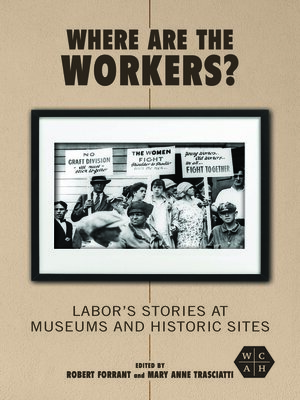Where Are the Workers?
ebook ∣ Labor's Stories at Museums and Historic Sites · Working Class in American History
By Robert Forrant

Sign up to save your library
With an OverDrive account, you can save your favorite libraries for at-a-glance information about availability. Find out more about OverDrive accounts.
Find this title in Libby, the library reading app by OverDrive.



Search for a digital library with this title
Title found at these libraries:
| Library Name | Distance |
|---|---|
| Loading... |
The labor movement in the United States is a bulwark of democracy and a driving force for social and economic equality. Yet its stories remain largely unknown to Americans. Robert Forrant and Mary Anne Trasciatti edit a collection of essays focused on nationwide efforts to propel the history of labor and working people into mainstream narratives of US history. In Part One, the contributors concentrate on ways to collect and interpret worker-oriented history for public consumption. Part Two moves from National Park sites to murals to examine the writing and visual representation of labor history. Together, the essayists explore how place-based labor history initiatives promote understanding of past struggles, create awareness of present challenges, and support efforts to build power, expand democracy, and achieve justice for working people.
"A much-needed contribution to larger and urgent national conversations around both organized labor and place-based public labor history. The need for (and threats to) unions, the struggle for fair wages, efforts to ensure workplace safety—the headlines of the present were the headlines of the past, too. These essays make the compelling case that museums and historic sites have, can, and must actively shape public understanding, while helping to inspire the activists and organizers of the future."—Marla Miller, coauthor of Bending the Future: Fifty Ideas for the Next Fifty Years of...
A wide-ranging blueprint for change, Where Are the Workers? shows how working-class perspectives can expand our historical memory and inform and inspire contemporary activism.
Contributors: Jim Beauchesne, Rebekah Bryer, Rebecca Bush, Conor Casey, Rachel Donaldson, Kathleen Flynn, Elijah Gaddis, Susan Grabski, Amanda Kay Gustin, Karen Lane, Rob Linné, Erik Loomis, Tom MacMillan, Lou Martin, Scott McLaughlin, Kristin O'Brassill-Kulfan, Karen Sieber, and Katrina Windon
| Cover Title Page Copyright Contents Acknowledgments Introduction: Uncovering Labor's History Part I. In Practice: Collecting and Interpreting the History for the Public Chapter 1. Public Memory and the West Virginia Mine Wars Museum Chapter 2. Interpreting Barre, Vermont's Granite Industry in All Its Rich Complexity Chapter 3. Lawrence, Massachusetts, and the 1912 Bread & Roses Strike at Street Level: Interpretation Over Time Chapter 4. "Like a Family" or "A Committee of Half-Starved Human Beings": Multiple Perspectives in Interpreting Southern Mill Labor History Chapter 5. History, Memory, and Community in the Redeveloped Loray Mill Chapter 6. "Cut Off from Fair Play": Representing Labor Issues in the Context of the Elaine Massacre Chapter 7. Corrective Collecting and Democratizing Documentation: Preserving, Interpreting, and Promoting Regional Workers' History at the Labor Archives of Washington Part II: Writing the History Chapter 8. Labor History and the National Park Service: How the Government Does and Does Not Remember Our Working Past Chapter 9. The Southern Tenant Farmers Museum and the Difficult History of Agricultural Organizing Chapter 10. Labor Sweated Here: Commemorating Workers and Their Activism in Paterson, New Jersey Chapter 11. Latinx Murals of Texas: Memorials to Immigrant Experience, Working-Class History, and Solidarity Chapter 12. Labor and Art: Interpreting the Maine Labor Mural Controversy Contributors Index Back cover |"Where are the Workers? has much to offer labor historians, public historians, and all readers who want to know more about how working people's stories are told and how those narratives can be presented more often, with more respect in museums and historic places." —North Carolina Historical Review"A much-needed contribution to larger and urgent national conversations around both organized labor and place-based public labor history. The need for (and threats to) unions, the struggle for fair wages, efforts to ensure workplace safety—the headlines of the present were the headlines of the past, too. These essays make the compelling case that museums and historic sites have, can, and must actively shape public understanding, while helping to inspire the activists and organizers of the future."—Marla Miller, coauthor of Bending the Future: Fifty Ideas for the Next Fifty Years of...







